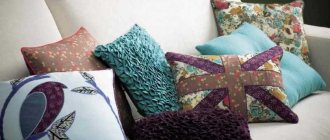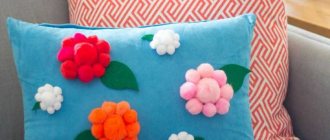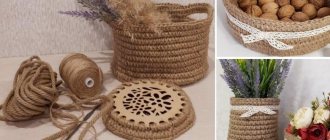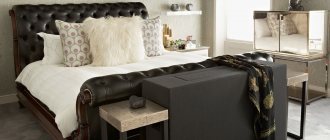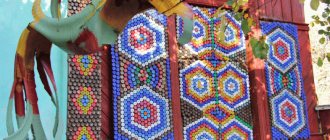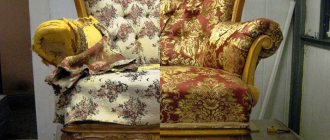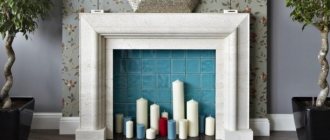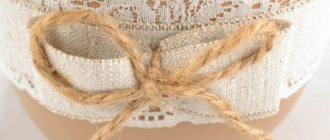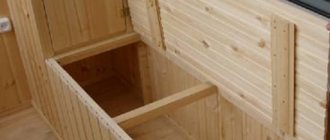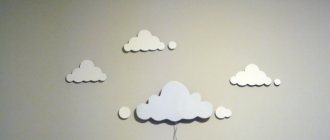Purpose of decorative pillows
Homemade pillows look great on sofas, will serve as an excellent addition to the interior of a child’s room, living room or bedroom, and will make a set of country furniture more comfortable.
A variety of pillows will find their place in any living space, on vacation, and even in a car.
A stylish hand-sewn pillow will be an excellent gift for a loved one, and making interesting options for interior pillows can bring additional income.
Types of decorative pillows
The most common pillows in the house are ordinary sofa pillows. But in practice, the choice is much greater: curly ones are not much different from handmade soft toys, flat rectangular and square ones fit perfectly on chairs, and soft and different-sized ones are ideal for a bed.
Decorative pillows can be round, oval, elongated, in the shape of rollers, butterflies, hearts, letters, flowers - don’t limit your imagination! To sew covers, choose dense and wear-resistant fabrics: velvet, satin, denim, leather, brocade, cotton, linen, burlap. Tassels, lace, frills, clips, folds, ruffles are suitable for decorations.
Types of decorative pillows
Interior pillows are in demand and popular not only as an element of room decor, but as a convenient household item.
Types of decorative pillows are divided into:
- classically shaped products for sofas that make relaxation more comfortable,
- rollers for beds and upholstered furniture,
- special pillows for the kitchen or dining room,
- floor pillows for a children's room or recreation area,
- small camping pillows that you can take with you outdoors,
- car pillows that make the trip more comfortable.
Pillows can have a classic or non-standard shape, depending on the purpose and imagination of the master. The size and design depend on the application of the decorative product.
Cushions
Some housewives decide to sew sofas; their role is not only to decorate the room, but also to complement the furniture. Often this need arises due to the lack of “relatives”; after purchase, they are often the first to be torn. It happens that it is impossible to purchase them for a certain sofa model, since they are no longer produced.
Sofa option
The principle of sewing sofa products is no different from the above: first, the fabric, padding, and threads are selected. Then a pattern is created according to which the product is sewn.
Rules
- Fabric compatibility. It may not be possible to find exactly the same material from which the sofa is made. In any case, the fabric should be dense; silk and satin will not be suitable options.
- Color. The shade of sofa accessories often differs from the sofa itself. There may be beige on brown, yellow on green, and red on black. Therefore, the color does not have to be identical, the main thing is that they match.
- Padding. They must be dense, so it is best to use dense padding polyester or another similar material.
The shade of sofa accessories often differs from the sofa itself
It’s difficult to leave sofa cushions solely for room decor; everyone who sits on it will lean on them. This needs to be taken into account when decorating; perhaps a good option would not be separate decoration, but simply choosing a multi-colored fabric with a pattern.
Fabrics
To make decorative pillows, it is better to take dense fabrics:
- natural cotton and linen materials,
- denim or knitted fabric,
- different types of fur and satin,
- furniture fabrics for upholstery.
To create a good pillow with your own hands, it is important to choose the right material in terms of properties, color and texture, so that the decorative product complements your home interior.
- Do-it-yourself bead brooch - 105 photos and video description of how to quickly and easily weave a brooch
DIY bird feeder - step-by-step master class and ideas for beginners and schoolchildren (155 photos)
Do-it-yourself beads: 120 photos and video description of how to weave beads
How to make a pattern for a pillow?
If the question arises of how to sew a decorative pillow, then first you need to make a pattern. Firstly, it is convenient and also allows you to avoid mistakes, and secondly, you can make several exact copies of pillows that will perfectly match in size. This is important, since unevenness is sometimes very noticeable and can ruin the overall effect of the presence of pillows.
It is best to make a pattern for a decorative pillow with your own hands and immediately draw up a drawing for the pillowcase
It is best to make a pattern for a decorative pillow with your own hands and immediately draw up a drawing for the pillowcase. This will make it more convenient to work and make calculations, because the pillowcase should be several centimeters larger than the pillow itself.
Overlock is used to make a decorative pillow with your own hands
As for how to sew a decorative pillow with your own hands, it is worth noting that this does not require any special education or sophisticated equipment. Of course, it is much easier to work when you have a sewing machine and overlocker at home, but in their absence, all the work can be done manually, although it will take much longer.
Sewing machine for making decorative pillows with your own hands
When drawing up a pattern, you need to determine the desired size of the pillow, make a square or rectangle on paper, and then add 1.5 cm to it for the seam. The pattern for a decorative pillow is transferred to double fabric, everything is stitched up to a certain point, and then turned inside out. It is important not to forget that the product will need to be filled with padding polyester. To do this you will need to leave a small opening. Through it, the pillow blank will be turned inside out, and then filled with synthetic filler. This opening is then carefully sewn together on the front side.
Next, you can start making the pillowcase. For it, you also need to make your own pattern based on the first one, but plus 2-3 cm. It is also unnecessary to forget that the pillowcase must have a special hole. If zippers or buttons are not used here, you need to leave a longer strip of fabric on one side; in the future, it will need to be folded inward so that it holds the pillow and prevents it from falling out of the pillowcase.
Scheme of a pillowcase with a smell
On a note! Professional seamstresses use special seams when making bed linen, including pillowcases.
They make the products more durable, but this is not necessary for a decorative pillow. If possible, you can overlock the seams or simply sew them by hand.
Filler
To fill pillows, natural, synthetic non-woven materials and natural raw materials are usually used.
Natural padding includes:
- down and/or feather of a bird,
- animal fur.
Such a filler requires high-quality care, since small parasites can appear in it.
Herbal filling involves the use of various aromatic herbs. The service life of such a pillow is short, it must be protected from moisture. Plant content has a positive effect on human health.
Synthetic fillers include non-woven artificial materials:
- Do-it-yourself dolls made of fabric - 145 photos and video description of how to sew a beautiful doll quickly and easily
- How to sew curtains for the kitchen - a detailed description of how and what to sew curtains for the kitchen from (video + 135 photos)
Do-it-yourself felt toys: ideas, patterns, templates and felt patterns (135 photos and videos)
- holobiber,
- foam rubber,
- padding polyester,
- small silicone beads.
The advantages of synthetic padding are ease of maintenance and long service life.
About buffs
Puffs on a suitable fabric, smooth and glossy, are another matter. When done correctly, they can be vacuumed and hand washed without any problems. And making all this splendor is not as difficult as it seems. First you need to learn how to read the diagrams for assembling puffs (assembling them, as sewing makers say).
As an example, diagrams for assembling simple puffs are shown in Fig. below. All puff patterns are built on an orthogonal-diagonal grid, the module of which (the side of the square) is 2-7 cm, depending on the size of the product and the density of the fabric. The grid in the diagram can be shown explicitly, as on the right in the figure, or its nodes can only be marked with dots, as on the left. The mesh is applied to the back of the workpiece with a textile marker in a mirror image.
Further, areas that are contracted (collected, assembled) into a buffer are marked either with converging arrows (on the left) or red lines (on the right), and those that are not contracted are marked with simple thin lines. The puffs can be assembled either with one thread or separately. The first method is for the lazy, because... a web of threads is formed from the inside. In any case, each puff is assembled with at least 3 stitches 4-5 mm wide, unless otherwise indicated in the notes to the pattern.
Popular articles Murchik of British blood
Examples of puff patterns for pillows
Then, the assembly sequence. It is produced in horizontal or vertical rows, again, unless otherwise indicated in the description of the pattern. In the case where the rows are indicated explicitly (on the left), they are displayed in numbering order and the buffs in the row are also assembled by numbers; here – Row 1 1-2, 3-4, etc., then Row 2 and so on. In the absence of an explicit indication of the rows (on the right), the puffs are assembled simply in numerical order; according to the diagram on the right - 1-2, 3-4, 5-6, 7-8, etc.
Try to assemble any scrap of fabric into puffs according to these entry-level patterns, and you will see that it will take little time, even if you assemble one at a time. And then watching a selection of master classes on making pillows with puffs that are much more spectacular and complex won’t seem like a nightmare:
Video: DIY buffalo pillows, master classes
Beginning of work
The first step in creating an interior pillow is to think about its purpose and appearance.
Having decided on the application, design, color and size of the future product, it is important to choose the right fabric for sewing.
The material should be in harmony with the rest of the home furnishings and correspond to the intended sketch.
Pillow Shape
It is not at all necessary to make a decorative product of the correct shape. The most popular are rectangles and squares, but the pillow can be oval, round, or in the shape of a letter and an animal.
The most popular are rectangles and squares, but the pillow can be oval, round, or in the shape of a letter and an animal.
For each type, you must first take care of drawing up a pattern. For complex shapes, you can find options in special editions, and simple, ordinary decorative pillows can be easily made with your own hands and according to your own drawings.
It is important to immediately think through not only the shape, but also the option for decorating the pillow. This is of great importance, otherwise the product will not look harmonious. The dimensions of the pillow also need to be selected carefully. For the living room, you should not use large pillows so that they do not clutter the room. But for a nursery, you can sew a large flat pillow on which the baby will be comfortable to play, and parents will not worry that their child will freeze.
Features of work
When sewing pillows, it is important to take into account the small nuances of working on this decorative item. The product consists of a pillowcase, filling and decorative cover. The top cover is made so that it is easy to remove for cleaning or washing.
When cutting, the size of the cover should be made a couple of centimeters larger than the pillowcases.
When considering how to sew decorative pillows with your own hands, it is worth considering these features of the work.
Schemes, patterns
The first thing to do is create a pattern. Only experienced professionals can sew any products “by eye”. And the result of such a negligent attitude will not always be a smooth, neat thing. It’s convenient to use the pattern - just calculate the measurements on paper to avoid mistakes.
Modeling the pattern will make the sewing process easier. It will also be possible to create as many identical products as you like according to the same design.
Pattern for a product in the shape of a cat
Creating a pattern takes place in several stages:
- We determine the size, draw a square or rectangle on paper, add 1.5 cm on each side.
- We transfer the pattern to the double fabric, sew it together, leaving a small opening for stuffing, and turn it inside out.
- We make a pillowcase. We make a second pattern, different from the first in size - each side should be a couple of centimeters larger.
If you have experience creating similar products, you don't have to limit yourself to a square or rectangular shape. It's best for beginners to start with. You can create more interesting patterns:
- owl;
- “boa constrictor” - under the head;
- elephant, etc.
Easy to sew with your own hands
To implement any of your ideas, you just need to draw them on paper, then transfer them to fabric. Still, in most cases, when they are intended for decorating a hall or living room, it is better to choose classic options. They will be rectangular or square in shape.
Work on creating a decorative pillow
It’s better to prepare everything for work in advance.
In addition to the fabric, you should stock up on:
- scissors,
- life-size patterns,
- a piece of dry soap or chalk,
- needles,
- threads,
- sewing machine,
- decorative elements.
Using decorative pillows
The bedroom is not the main place for pillows. The cushion base is suitable for creating soft parts of furniture. In the kitchen, their location in corner structures is ideal. This will make sitting at the table much more comfortable.
Choose space for decoration outside the walls of the apartment. This type of textile is also placed in the gazebo in the garden. Do you have an open veranda? Fill it with comfort with pillows.
The interior is changing before our eyes. You can play with its severity by using textures, colors and prints of decorative items. Decor consists of decorating the upholstery of products - covers. It is necessary to create on them.
Pillows are applicable everywhere. They will not be superfluous on armchairs, chairs, sofas and other relaxation spaces. Textiles set the style of the room. The predominance of marine motifs in the room can be reflected in the pillow.
It contains images of the sea, shells, marine life and bluish colors predominate. Children's original pillows, calm products for the living room or bright kitchen pillows will allow your imagination to run wild.
The procedure for making a simple interior pillow
It is recommended to wash new fabrics before cutting parts, as they may shrink.
- Having placed the pattern on the wrong side of the material, it should be traced along the contour. For convenience, the pattern should be secured with pins.
- The parts are cut with scissors, taking into account the margin for seams.
- Having folded the parts of the product with the right side inward, sew the seams. It is better to sew using a sewing machine, but you can do the work by hand.
- One side is not completely stitched; the product must be turned inside out and ironed.
- Decorate the pillow, fill it and sew up the seam.
A simple square pillow will not require much effort or time to work. A master class on making decorative pillows with your own hands can be easily found online and in video format.
Preparing to sew
Since soft decorative objects are often moved from place to place, dropped, and children play with them. Therefore, to create them you need to choose durable fabric, safe padding with an elastic texture that does not change its shape under physical influence. Sewing beautiful sofa cushions consists of several stages: choosing the material, selecting the appropriate padding and sewing itself.
Choosing fabric
Choosing fabric for thinking is the very first and most important stage. The main quality of the selected material should be strength. If you still have no idea how to sew a pillow for a sofa with your own hands, then it is best to choose simple fabrics: cotton or chintz. Also commonly used fabrics: felt, silk, linen, upholstery material or calico. For knitted pillows, it is best to use old knitted sweaters or unnecessary bulky jumpers. An important factor in the material used should be color fastness and texture density so that the padding material does not fall out.
Pros and cons of different types of fabrics
Natural fabrics:
- Calico fabric is easy to care for, has a light and breathable texture. Cons: sensitive to high temperatures, can shrink, easily wrinkled and short-lived material.
- Silk is distinguished by its strength and wear resistance, can be washed at a fairly high temperature (about 110 degrees), and is a highly breathable material. Cons: wrinkles easily, the price is quite high.
- Linen fabric is hypoallergenic, breathable, and washable. Cons: shrinks quickly and wrinkles very easily, the material itself is harsh.
For the interior:
Jeans, flannel and felt are fabrics of denser origin, which have their own characteristics:
- Jeans or denim is a breathable and quite durable fabric, the colors look very stylish and fashionable, and are environmentally friendly. Cons: highly susceptible to fading, hardens and shrinks after washing.
- Fleece is a budget fabric, pleasant to the touch and practical to use, hypoallergenic. Disadvantages: during sewing it frays a lot, which causes certain difficulties, and the fabric is absolutely not elastic.
- Felt - there are no back and front sides, which simplifies its use, a large range of colors, containing 90-100% wool. Cons: pills may appear after washing, it is afraid of high heating temperatures, both during washing and during steam treatment, and if washed incorrectly, it loses its shape.
You might be interested in How measurements are taken for sewing men's trousers and clothing
Additional Information! When sewing decorative pillows, a combination of fabrics is allowed; one side can be linen and the other silk. It looks unusual and beautiful. You can also create your own patterns from many scraps of different fabrics. This type of needlework is called patchwork.
Curtain to match the style of pillows
Filler selection
Just sewing a pillowcase is only a small part of the work done; it still needs to be stuffed. There are two types of padding:
- Natural filler (plant or animal origin).
- Artificial filler.
The advantages of natural fillers, in this case of animal origin, are their long service life, practically no caking, and maintain good sanitary and hygienic properties. The only thing is that such material is rarely used when sewing decorative pillows, since they are not fluffed like sleeping pillows. Such fillers include feathers and down.
Fillers of plant origin are often used for medicinal purposes or for people with certain types of allergies to down or synthetics. The filling can be: bamboo, medicinal herbs, buckwheat husks or hop cones. Cons: this material has the ability to rot, become damp and even rot, so it requires very careful care.
Original design
Artificial filler: holofiber and synthetic fluff. These are the most recommended materials that will not lose their elasticity over the years. Cotton wool, padding polyester, etc., these materials are absolutely not suitable for stuffing decorative pillows, as they tend to quickly clump and cake.
For pillows in a children's room, it is best to use silicone granules; also, this type of material does not get wet and is hypoallergenic.
Important! Dummies with artificial filling can be easily washed in a washing machine, eliminating accumulated dust, which is not permissible with filling made from natural materials.
Necessary items for sewing:
- Scissors;
- Fabric and padding, zipper (for certain types of pillows);
- Sewing machine (can also be sewn by hand);
- Tailor's pins and needles;
- Meter or simple ruler, chalk;
- Threads, pattern on cardboard or instructions;
- Iron.
Step-by-step master class on sewing pillows
All materials are prepared, tools are collected, you can start sewing the pillow:
- We decide what size and shape the thought will be, let’s say a square, 50x50 cm.
- On the laid out fabric from the wrong side you need to draw two 50x50 squares, adding 2-3 cm around the perimeter for the seam.
- Folded squares with the front part facing inward should be pierced with pins along the perimeter so that the fabric does not move out and cut out.
You might be interested in this Manual for the Chaika 134 A sewing machine: how to set it up correctly
Furniture cushion
The next stage is stitching the prepared parts:
- You need to start sewing by stitching 3 sides of the cut pieces, without removing the pin so that the fabric does not slip. Retreating the same 2-3 cm that were left in reserve.
- Bend the resulting seams to one side and iron them thoroughly, then turn them right side out.
- Fill the resulting pillowcase with the selected filling and stitch the remaining side, bending the seam inward.
Large sofa cushion
Cushions for sofas of impressive size require good skill and acquired practice during sewing. The sewing algorithm is exactly the same as for standard products that were described earlier. It is enough to increase the dimensions of the finished pattern to the required parameters. Large sofa cushions can also be made under furniture, covered with upholstery furniture textiles.
Cushion
The furniture cushion that complements the sofa usually has a simple geometric shape. Most often it is a rectangle.
Such items are subject to wear and tear during use faster than the sofa itself. The opportunity to buy a similar pillow is not provided by furniture manufacturers.
Therefore, there is a need to sew such a pillow yourself. This is a simple job, most of the success of which lies in the correct selection of material for the cover.
If possible, the fabric should be found similar to the upholstery of the sofa. If there is no such fabric, then you need to think through the design of a new pillow so that it fits organically into the interior.
In any case, the texture should match the upholstery of the sofa, and the color should be in harmony with the design of the room.
The easiest way to copy a factory copy is to rip open the old one and measure the cover.
Using these measurements, draw a drawing, cut and seam the parts of the new product.
DIY sofa cushions from old jeans
Jeans that are torn or out of style are a great material for a sofa cushion. This fabric is practical and looks beautiful.
The easiest way is to make small decorative pillows from straight leg pants.
Here's how to sew a denim stitched pillowcase:
- Cut a rectangle or square from a single pant leg of any size. This will be the shape of the future pillow.
- Sew decorations to the front side (pre-cut pockets, lace flower, scraps of fabric).
- Sew one edge to create an outer seam. In this case, leave a 2 cm margin.
- Fill the pillow with down, feathers, hay, batting or padding polyester.
- Sew the second edge with the seam facing outwards with a 2cm margin.
- Pull 2-3 threads from the weft of the outer stitches to create a fringe.
Decorative design
The most fun part of the creative process of creating an interior pillow is thinking about its design.
The easiest way is to use plain textured fabrics, the color of which matches the design of the room.
Pillows for a children's room often serve as an element of games. They should have bright colors and interesting design.
In children's design, bright applications on cartoon and fairy tale themes, original pillow toys in the shape of stylized animals or famous cartoon characters are appropriate.
You can make your own children's decorative pillows from a bright T-shirt with an original design that is too small for the child. Patterns for sewing funny children's pillows can be easily found online or drawn yourself.
You can complement the interior pillow with stylish appliqué, embroidery, satin ribbons, additional details in the form of an overhead bow or animal ears, fringe or frills.
External design depends on the skill and imagination of the craftsman, as well as on the purpose of the product.
Popular design trends allow the use of appropriate decorative methods: patchwork, stylized ornaments, thematic embroidery, tassels, bows, and so on.
The main thing is that the result of the work is a comfortable decorative pillow that harmoniously fits into the interior design.
Types of pillows
There are an unlimited number of types of pillows, different shapes, sizes and purposes. Duma can look not only like a classic pillow, but also like a fairy-tale character, a car or an animal. Several main types used in decoration:
- A cushion is a small pillow, the second name of which is dumka, often used not only as an accessory, but also as a soft cushion under the head during daytime sleep.
- Sectional - consists of several volumetric inserts sewn together with ribbed inserts, in appearance it resembles sewing in a patchwork style.
- Turkish - often decorated with currency exchangers and tassels, the shape is slightly oblong, the embroidery on the fabric is reminiscent of oriental patterns.
- Quilted - comes in various shapes: rectangular, oval, round or square. A distinctive feature of this pillow is the quilted surface of the cover.
- Oxford - features additional stitching around the perimeter, which separates the border without padding. The piping accompanies the pillow around the entire perimeter.
You may be interested in Sewing gauze diapers for a newborn according to step-by-step instructions
Oxford pillow
Photos of decorative pillows with your own hands
Tell your friends
